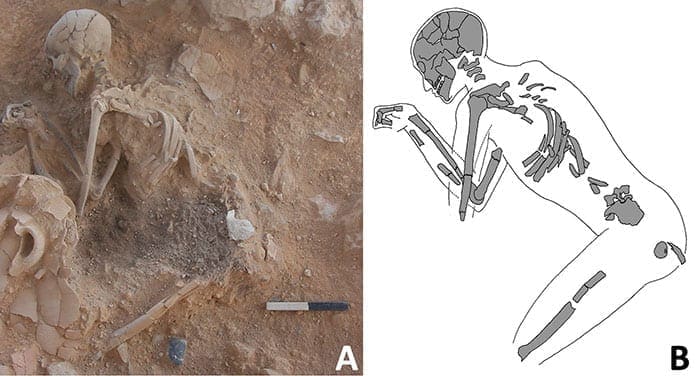More than 3,000 years ago, four people were incinerated and crushed in a blazing fire in the south central city of Azekah, Israel.
Their remains were trapped in rubble until discovered by Tel Aviv University archeologists in 2012. That’s when Karl Berendt began volunteering at the excavation site as an undergraduate student at the University of Alberta.
It wasn’t until he began a forensic analysis of those charred bones in graduate school, however, that details of the fire and the lives it claimed began to emerge.
“The central pillar of my master’s thesis was doing what we call an osteobiography – using the bones to tell the story of somebody’s life,” said Berendt.
“Once I got to the end of my undergrad years and I realized that nobody was going to be working on these skeletons, I decided it was my opportunity. It seemed a shame that these people weren’t ceremonially buried; they were accidentally buried, and nobody came back for them.”
With the help of his thesis supervisor, anthropologist Sandra Garvie-Lok, and colleague Pamela Mayne Correia – an expert in the analysis of cremated skeletal material – Berendt began piecing together the final moments in the lives of these figures from the late Bronze Age, or late 12th century BCE.
The results are now published in the International Journal of Osteoarchaeology, with Berendt as lead author. Garvie-Lok calls it an exceptionally rare study, marshalling the skills of experts in the U of A’s Department of Anthropology and research partners at Tel Aviv University.

The bones of the ancient fire victims reveal clues into how they died—and how they lived, with signs showing that they worked hard, likely had poor nutrition and had diseases common among people in the region during the late Bronze Age. (Photo courtesy of Karl Berendt)
“There are some other ancient fire sites with human remains that have been excavated, but nothing with this kind of detail,” said Garvie-Lok. “To have a thorough analysis like this – including isotopic chemical work and Mayne Correia’s expert examination of burnt remains – is pretty unusual.”
Bones tell a story
The team first discovered that three of the four fire victims were very young – a male or female in their early teens, and a female in her late teens and a male in his late teens or early adulthood. The fourth was an older female, around 35 to 45 years old, said Berendt.
“These people were united for some reason, because they were in the same building, but it’s unclear whether that was family ties, or whether they were co-workers.”
There were also the markings of disease on the bones – signs of possible childhood malnutrition and anemia – consistent with what anthropologists know of the social and political conditions in that region during the late Bronze Age.
“There were widespread political changes across the eastern Mediterranean world,” said Berendt. “In places like Israel, you have simultaneous destruction of a bunch of different cities across the landscape, while other cities are left untouched, suggesting there’s something political going on here – there’s a pattern.”
At the same time, the climate was getting drier, likely causing decades of crop failure.
“All of that along with the skeletal evidence combines to show that (the fire victims) worked hard, may not have had good nutrition, and disease was part of their lives,” he said.
Evidence also shows that the fire in which they perished was extremely hot.
“The bones were discoloured and broken, and patterns show they were burned to very high temperatures,” said Berendt. “But they didn’t completely turn to ash, showing they were held in place,” probably by collapsed rubble.
“We think the fire smouldered and nobody came back to dig these people’s remains out of the rubble.”

Karl Berendt’s master’s research in anthropology reveals insights into the lives and deaths of four people who died more than 3,000 years ago in a fire in the ancient city of Azekah, Israel. (Photo: John Ulan)
Garvie-Lok said the detailed analysis paints a striking picture of the last moments in the lives of these people.
“I could almost see the building and you can just imagine how scared these people would have been,” she said.
“Based on the positioning of one of the individual’s arms and how it broke, it looks like they were knocked onto their back, or fell because of fumes, and then rolled over, with one hand above their face when something large and heavy crashed down on them.”
The cause of the fire is unknown, said Berendt, but one possibility is that it was aided by an accelerant. After conducting a residue analysis on pottery in the building, one member of the team concluded the vessels may have contained flammable plant and animal products.
A holistic picture of people
Berendt is now in medical school at the U of A, following in his father’s footsteps as a physician with a passionate interest in anthropology. He said the two fields of study aren’t as disparate as they might at first seem.
“It seemed a surprisingly natural transition, looking at the markers that everyday life leaves on the bones (of skeletal remains) and the things that connect their physical and social experience.
“Moving into medicine, you see how social experience leaves marks on the body. You’re seeing the same process in both the dead and the living, and I found it really interesting and fulfilling to be able to use anthropology to form a more holistic picture of the people I’m treating.”
While Berendt is now considering pediatrics as his specialty, he also hopes to continue publishing anthropological research “as far as I’m able.”
| By Geoff McMaster for Troy Media
This article was submitted by the University of Alberta’s Folio online magazine. The University of Alberta is a Troy Media Editorial Content Provider Partner.
© Troy Media
Troy Media is an editorial content provider to media outlets and its own hosted community news outlets across Canada.

